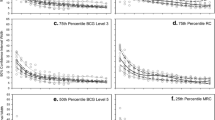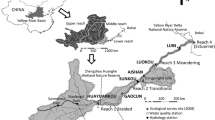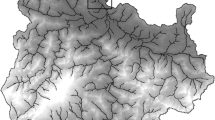Abstract
The objectives of the Environmental Monitoring and Assessment Program for Great River Ecosystems (EMAP-GRE) are to (1) develop and demonstrate, in collaboration with states, an assessment program yielding spatially unbiased estimates of the condition of mid-continent great rivers; (2) evaluate environmental indicators for assessing great rivers; and (3) assess the current condition of selected great river resources. The purpose of this paper is to describe EMAP-GRE using examples based on data collected in 2004–006 with emphasis on an approach to determining reference conditions. EMAP-GRE includes the Upper Mississippi River, the Missouri River, and the Ohio River. Indicators include biotic assemblages (fish, macroinvertebrates, plankton, algae), water chemistry, and aquatic and riparian physical habitat. Reference strata (river reaches for which a single reference expectation is appropriate) were determined by ordination of the fish assemblage and examination of spatial variation in environmental variables. Least disturbed condition of fish assemblages for reference strata was determined by empirical modeling in which we related fish assemblage metrics to a multimetric stressor gradient. We inferred least disturbed condition from the y-intercept, the predicted condition when stress was least. Thresholds for dividing the resource into management-relevant condition classes for biotic indicators were derived using predicted least disturbed condition to set the upper bound on the least disturbed condition class. Also discussed are the outputs of EMAP-GRE, including the assessment document, multimetric indices of condition, and unbiased data supporting state and tribal Clean Water Act reporting, adaptive management, and river restoration.
Similar content being viewed by others
References
Angradi, T. R. (Ed.). (2006). Environmental monitoring and assessment program, Great River ecosystems field operations manual. EPA/620/R-06/002, U.S. Environmental Protection Agency, Office of Research and Development, Washington, D.C. www.epa.gov/emap/greatriver/. Accessed 20 February 2008
Angradi, T., Bolgrien, D., Meyer, R., Nawrocki, T., & Starry M. (2006a). GIS model for assessing potential great river reference reaches. Paper presented at the American Water Resources Association 2006 Spring Specialty Conference on GIS and Water Resources IV, Houston, Texas
Angradi, T. R., Schweiger, E. W., & Bolgrien, D. W. (2006b). Inter-habitat variation in the benthos of the Upper Missouri River (North Dakota, USA): Implications for Great River bioassessment. River Research and Applications, 22, 755–773.
Angradi, T. R., Schweiger, E. W., Bolgrien, D. W., Ismert, P. C., & Selle, T. (2004). Bank stabilization, riparian land use and the distribution of large woody debris in a regulated reach of the Upper Missouri River, North Dakota, USA. River Research and Applications, 20, 829–846.
Barbour, M. T., & Yoder, C. O. (2000). The multimetric approach to bioassessment as used in the United States of America. In J. F. Wright, D. W. Sutcliffe, & M. T. Furse (Eds.), Assessing the biological quality of fresh waters: RIVPACS and other techniques (pp. 281–292). Ambleside, Cumbria: Freshwater Biological Association.
Bayley, P. B. (1995). Understanding large river-floodplain ecosystems. BioScience, 45, 153–158.
Benke, A. C., & Cushing, C. E. (Eds.) (2005). In Rivers of North America. Burlington, MA: Elsevier Academic.
Blevins, D. W. (2006). The response of suspended sediment, turbidity, and velocity to historic alterations of the Missouri River. U.S. Geological Survey Circular 1301.
Blocksom, K. A. (2003). A performance comparison of metric scoring methods for a multimetric index for mid-Atlantic highlands streams. Environmental Management, 31, 670–682.
Bowman, M. F., & Somers, K. M. (2005). Considerations when using the reference condition approach for bioassessment of freshwater ecosystems. Water Quality Research Journal of Canada, 40, 347–360.
Cade, B. S., & Noon, B. R. (2003). A gentle introduction to quantile regression for ecologists. Frontiers in Ecology and the Environment, 1, 412–420.
Chick, J. (2006). Zooplankton indicators for Great River bioassessment. (Paper presented at the EPA EMAP-GRE Reference Condition Workshop, Cincinnati, Ohio). www.epa.gov/emap/greatriver/rcw/Chick.pdf. Accessed 20 February 2008
DeLong, M. D. (2005). Upper Mississippi River Basin. In A. C. Benke & C. E. Cushing (Eds.), Rivers of North America (pp. 327–373). Burlington, MA: Elsevier Academic.
Emery, E. B., Simon, T. P., McCormick, F. H., Angermeir, P. L., DeShon, J. E., Yoder, C. O., et al. (2003). Development of a multimetric index of assessing the biological condition of the Ohio River. Transactions of the American Fisheries Society, 132, 791–808.
Fremling, C. R. (2005). Immortal river: The Upper Mississippi in ancient and modern times. Madison: The University of Wisconsin Press.
Galat, D. L., Berry, C. S., Gardner, W. M., Hendrickson, J. C., Mestle, G. E., Power, G. J., et al. (2005a). Spatiotemporal patterns and changes in Missouri River fishes. In J. N. Rinne, R. M. Hughes, & B. Calamusso (Eds.), Historical changes in large river fish assemblages of the Americas (pp. 249–291). Bethesda, MD: American Fisheries Society.
Galat, D. L., Berry, C. S., Peters, E. J., & White, R. G. (2005b). Missouri River Basin. In A. C. Benke & C. E. Cushing (Eds.), Rivers of North America (pp. 427–480). Burlington, MA: Elsevier.
Gore, J. A., & Shields, F. D. (1995). Can large rivers be restored? BioScience, 45, 142–152.
Graf, W. L. (2001). Damage control: Restoring the physical integrity of America’s rivers. Presidential Address. Annals of the Association of American Geographers, 91, 1–27.
Hesse, L. W. (1996). Floral and faunal trends in the middle Missouri River. In D. L. Galat & A. G. Frazier (Eds.), Overview of river-floodplain ecology of the Upper Mississippi River Basin, Volume 3, Science for floodplain management into the 21st century (pp. 73–90). Washington D.C.: United States Government Printing Office.
Homer, C., Huang, C., Yang, L., Wylie, B., & Coan, M. (2004). Development of a 2001 national landcover database for the United States. Photogrammetric Engineering and Remote Sensing, 70, 824–840.
Hughes, R. M. (1995). Defining acceptable biological status by comparing with reference conditions. In W. Davis & T. Simon (Eds.), Biological assessment and criteria: Tools for water resource planning and decision making for rivers and streams (pp. 31–47). Boca Raton, FL: Lewis.
Hughes, R. M., Larsen, D. P., & Omernik, J. M. (1986). Regional reference sites: A method for assessing stream potential. Environmental Management, 10, 629–635.
Jackson, D., & Davis, W. (1994). Meeting the goal of biological integrity in water-resource programs in the U.S. Environmental Protection Agency. Journal of the North American Benthological Society, 13, 591–597.
Jackson, L. E., Kurtz, J. C., & Fisher, W. S. (Eds.) (1999). In Evaluation guidelines for ecological indicators. EPA/620/R-99/005. Washington, D.C.: U.S. Environmental Protection Agency, Office of Research and Development.
Jacobson, R. B., & Galat, D. L. (2006). Flow and form in rehabilitation of large-river ecosystems: An example from the Lower Missouri River. Geomorphology, 77, 249–269.
Johnson, B. J., Richardson, W. B., & Naimo, T. J. (1995). Past, present, and future concepts in larger river ecology. BioScience, 45, 131–145.
Junk, W. J., Bayley, P. B., & Sparks, R. E. (1989). The flood pulse concept in river-floodplain systems. Canadian Special Publications in Fisheries and Aquatic Science, 106, 110–127.
Karr, J. R., & Chu, E. W. (1999). Restoring life in running waters. Washington, D.C.: Island.
Kaufmann, P. R., Levin, P., Robison, E. G., Seeliger, C., & Peck, D. (1999). Quantifying physical habitat in wadeable streams. EPA/600/3-88/021a. Washington, D.C.: U.S. Environmental Protection Agency, Office of Research and Development.
Lazorchak, J. M., Hill, B. H., Avrill, D. K., Peck, D. V., & Klemm, D. J. (Eds.) (2000). Environmental monitoring and assessment program—surface waters: Field operations and methods for measuring the ecological condition of non-wadeable rivers and streams. U.S. Environmental Protection Agency, Cincinnati, OH. http://www.epa.gov/emap/html/pubs/docs/groupdocs/surfwatr/field/nonws1.html. Accessed 20 February 2008
Lyons, J. L., Piette, R. P., & Niermeyer, K. W. (2001). Development, validation and application of a fish-based index of biotic integrity for Wisconsin’s Large Warmwater Rivers. Transactions of the American Fisheries Society, 130, 1077–1094.
McDonald, M., Blair, R., Bolgrien, D., Brown, B., Dlugosz, J., Hale, S., et al. (2004). The U.S. environmental protection agency’s environmental monitoring and assessment program. In G. B. Wiersma (Ed.), Environmental monitoring (pp. 649–668). New York: CRC.
Moulton, S. R. II, Kennon, J. G., Goldstein, R. M., & Hambrook J. A. (2002). Revised protocols for sampling algal, invertebrate and fish communities as part of the National Water-Quality Assessment Program. U.S. Geological Survey Open-File Report 02-150, Reston, VA
Norris, R. H., & Thoms, M. C. (1999). What is river health? Freshwater Biology, 41, 197–209.
NRC (2002). The Missouri River ecosystem: Exploring the prospects for recovery. The National Research Council. Washington, D.C.: National Academy Press.
Palmer, M. A., Bernhardt, E. S., Allan, J. D., Lake, P. S., Alexander, G., Brooks, S., et al. (2005). Standards for ecologically successful river restoration. Journal of Applied Ecology, 42, 208–217.
Peck, D. V., Lazorchak, J. M., & Klemm, D. J. (Eds). (2001). EMAP surface waters: Western pilot study field operations manual for wadeable streams. U.S. Environmental Protection Agency, Office of Research and Development, Washington, D.C. http://www.epa.gov/emap/html/pubs/docs/groupdocs/surfwatr/field/ewwsm01.html. Accessed 20 February 2008
Prato, T. (2003). Adaptive management of large rivers with special reference to the Missouri River. Journal of the American Water Resources Association, 39, 935–946.
Schweiger, E. W., Bolgrien, D. W., Angradi, T. R., & Kelly, J. R. (2004). Environmental monitoring and assessment of a great river ecosystem: the upper Missouri River pilot. Environmental Monitoring and Assessment, 103, 5–20.
Seegert, G. (2000). Considerations regarding development of index of biotic integrity metrics for larger rivers. Environmental Science and Policy, 2, s99–s106.
Simon, T. P., & Lyons, J. (1995). Application of the index of biotic integrity to evaluate water resource integrity in freshwater ecosystems. In W. S. Davis & T. P. Simon (Eds.), Biological assessment and criteria: Tools for water resource planning and decision making (pp. 245–262). Boca Raton, FL: Lewis.
Simon, T. P., & Sanders, R. E. (1999). Applying an index of biotic integrity based on great-river fish communities: Considerations in sampling and interpretations. In T. P. Simon (Ed.), Assessing the sustainability and biological integrity of water resources using fish communities (pp. 479–505). Boca Raton, FL: CRC.
Sparks, R. E. (1995). Need for ecosystem management of large rivers and their floodplains. Bioscience, 45, 168–182.
Stevens Jr., D. L. (1997). Variable density grid-based sampling designs for continuous spatial populations. Environometrics, 8, 167–195.
Stoddard, J. L., Larsen, D. P., Hawkins, C. P., Johnson, R. K., & Norris, R. H. (2006). Setting expectations for ecological condition of running waters: The concept of reference condition. Ecological Applications, 16, 1267–1276.
Stoddard, J. L., Peck, D. V., Olsen, A. R., Larsen, D. P., Van Sickle, J., Hawkins, C.P., et al. (2005b). Environmental Monitoring and Assessment Program (EMAP): Western streams and rivers statistical summary. EPA/620/R-05/006, U.S. Environmental Protection Agency, Office of Research and Development, Washington, D.C. www.epa.gov/emap/west/html/docs/wstream.html. Accessed 20 February 2008.
Stoddard, J. L., Peck, D. V., Olsen, A. R., Paulsen, S. G., Van Sickle, J., Herlihy, A. T., et al. (2005a). An ecological assessment of western streams and rivers. EPA/620/R-05/005. Washington, D.C.: U.S. Environmental Protection Agency, Office of Research and Development.
Strobel, C. J., & Heitmuller, T. (2001). National coastal assessment field operations manual. EPA/620/R-01/003. Washington, D.C.: U.S. Environmental Protection Agency.
Thoms, M. C., Ogden, R. W., & Reid, M. A. (1999). Establishing the condition of lowland floodplain rivers: A palaeo-ecological approach. Freshwater Biology, 41, 407–423.
Thorp, J. E. (1992). Linkage between islands and benthos in the Ohio River, with implications for riverine management. Canadian Journal of Fisheries and Aquatic Sciences, 49, 1873–1882.
USEPA (2006). Best practices for identifying reference condition in Mid-Atlantic streams. EPA/260/F/06/002. Washington, D.C.: U.S. Environmental Protection Agency, Office of Environmental Information.
USGS. (1999). Ecological status and trends of the Upper Mississippi River System -1998: A report of the long term resource monitoring program. U.S. Geological Survey, Upper Midwest Environmental Sciences Center, La Crosse, Wisconsin. LTRMP 99-T001.
Van Sickle, J., Stoddard, J. L., Paulson, S. G., & Olsen, A. R. (2006). Using relative risk to compare the effects of aquatic stressors at a regional scale. Environmental Management, 38, 1020–1030.
White, D., Johnston, K., & Miller, M. (2005). Ohio river basin. In A. C. Benke & C. E. Cushing (Eds.), Rivers of North America (pp. 375–424). Burlington, MA: Elsevier.
Author information
Authors and Affiliations
Corresponding author
Rights and permissions
About this article
Cite this article
Angradi, T.R., Bolgrien, D.W., Jicha, T.M. et al. A bioassessment approach for mid-continent great rivers: the Upper Mississippi, Missouri, and Ohio (USA). Environ Monit Assess 152, 425–442 (2009). https://doi.org/10.1007/s10661-008-0327-1
Received:
Accepted:
Published:
Issue Date:
DOI: https://doi.org/10.1007/s10661-008-0327-1




